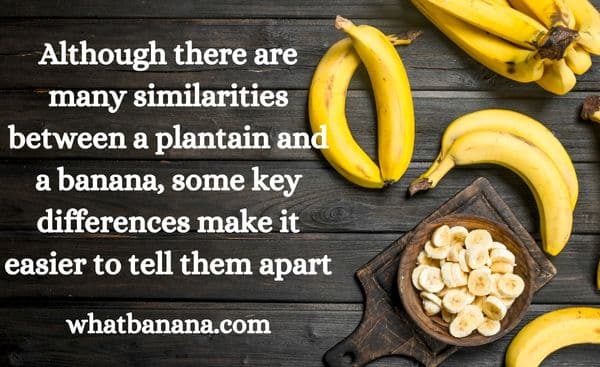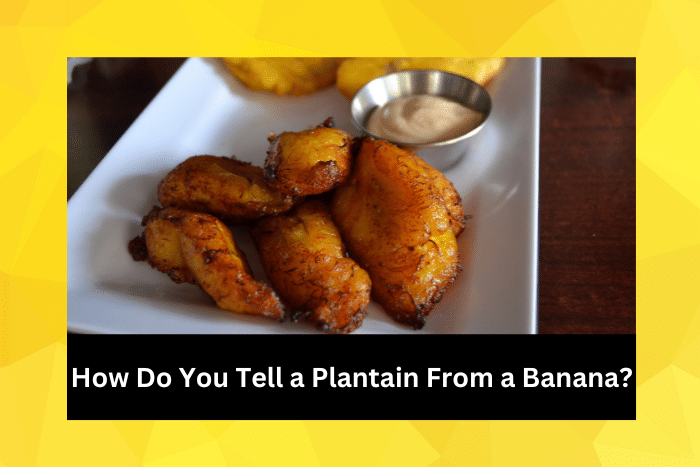If you have ever seen these fruit side by side, you may be wondering how you tell a plantain from a banana.
They do look pretty much the same, after all.
Are they grown in different countries?
Do they taste the same?
Do they have the same nutritional value?
Let’s take a look at plantains and bananas.
Although there are many similarities between a plantain and a banana, some key differences make it easier to tell them apart. The first indication is the size, as plantains are bigger than bananas and have a thicker peel. Plantains come in a variety of colors, not just yellow, such as green and dark brown. Bananas are much sweeter than plantains and can be eaten raw, whereas plantains need to be cooked. Both types of fruit are very nutritious, although plantains have slightly more calories. They are both a good source of antioxidants, fiber, vitamins, and minerals.
What’s the Difference Between a Banana and a Plantain?
At first glance, bananas and plantains look pretty similar, and it may be difficult to tell them apart.
But believe me, you really don’t want to bite into raw plantain; it’s a bit like eating a raw potato!
So, first of all, take a look at the size of the fruit.
(Although, from a scientific point of view, a banana is a herb, not a fruit, just to confuse matters!)
Plantains are much bigger than bananas and have tough, thick skin that is not as easy to peel and may require the use of a knife.
They can grow up to 12 inches long, as opposed to bananas that rarely exceed six inches.
Once you peel a plantain, the fruit inside is usually quite dry, whereas a banana is much softer and almost has a slippery texture.
Although they are both typically yellow at some stage in the ripening process, bananas and plantains do come in different colors.
Plantain can also be green when ripe or dark brown, but then again, so can a banana!
The true difference between a plantain and a banana is in the taste.
Bananas are lovely and sweet and can be eaten raw.
Plantain needs to be cooked and is more often used in savory dishes.
In terms of nutrition, plantains and bananas are pretty much the same.
However, plantains have a few more calories and higher carb content.
Both fruits are said to be anti-inflammatory, and the high fiber content helps with digestive problems.
They are both grown all over the world, particularly in South-East Asia, and require the same environmental conditions to flourish.

What are the Culinary Differences Between Bananas and Plantains?
As mentioned earlier, plantains need to be cooked, they are not edible raw.
Typically, they are baked, boiled, or fried,
However, even when cooked, they have a very different taste from bananas.
As such, they are not really interchangeable in recipes, you wouldn’t substitute banana with plantain in a sweet dessert!
Plantains do get somewhat sweeter as they cook and can even caramelize, but realistically, they will still have an underlying vegetable flavor.
Plantain can be used at all stages of its ripening process, whereas bananas are rarely eaten when underripe.
So, if you are looking for something sweet to use in a dessert or smoothie, for example, then a banana is your best bet.
But when it comes to savory dishes, then the plantain reigns supreme!
They soak up any additional seasonings, such as herbs or spices.
In fact, plantain is a popular ingredient in side dishes served with the main meal in the Caribbean, Africa, and Latin America.
They are widely accessible and very affordable, making them a key staple food in most households.
Bananas vs. Plantains
Final Thoughts
Plantains and bananas may look similar, but there are some key differences.
Plantain can be twice the size of a banana, up to 12 inches long, and cannot be eaten raw.
Bananas are much sweeter and typically used in desserts.
Plantain has to be cooked and is used as a savory element in a side dish.
They both have similar nutritional values, but plantains have more calories.
Please don’t mix them up; you might regret it!
And if you have an allergy, I have also written about why you can eat plantains but not bananas.
